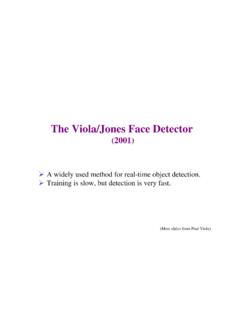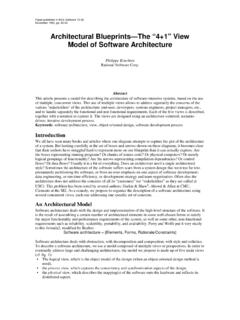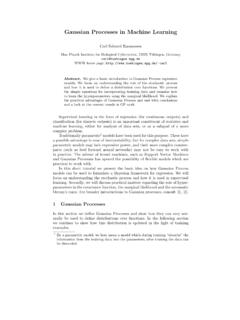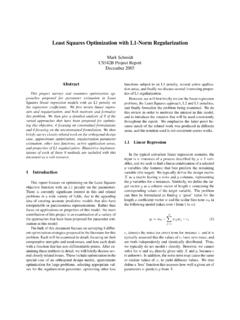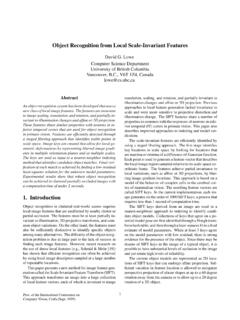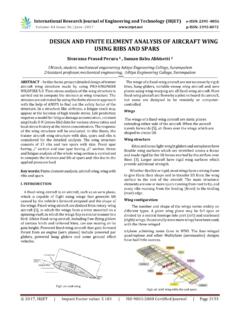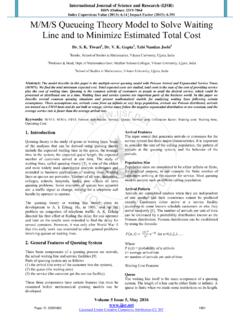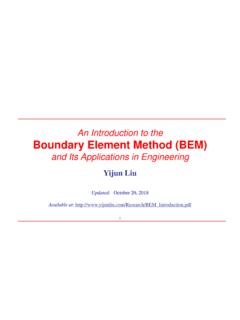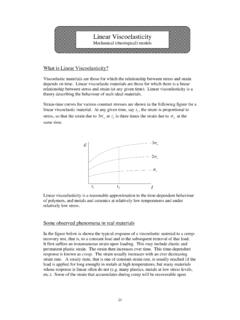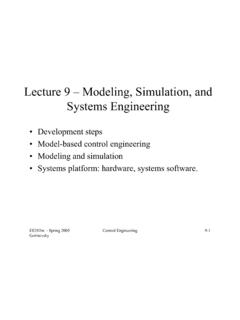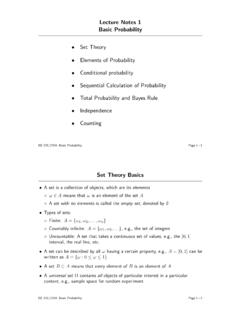Transcription of FLUID SIMULATION - University of British Columbia
1 FLUIDSIMULATIONSIGGRAPH 2007 Course NotesRobert Bridson1 University of British ColumbiaComputer Science Department201-2366 Main MallVancouver, V6T 1Z4, CanadaMatthias M uller-Fischer2 AGEIA PhysXTechnoparkstrasse 18005 Zurich, SwitzerlandAugust 10, DescriptionAnimating fluids like water, smoke, and fire by physics-based SIMULATION is increasingly important in visual effectsand is starting to make an impact in real-time games. This course goes from the basics of 3D FLUID flow to the stateof the art in graphics. We will begin with an intuitive explanation of the important concepts in FLUID SIMULATION ,and as we progress demonstrate how to implement an effective smoke and water SIMULATION system, complete withirregular curved boundaries and surface tension.
2 The last half of the course will cover advanced topics such as fireand explosions, adaptive grid methods, real-time-capable algorithms together with the latest technology in hard-ware acceleration, and non-Newtonian fluids like sand. Intuition and implementation details will be of AudienceDevelopers in industry who want to implement or at least understand the state of the art in graphics FLUID simulations,and researchers new to the with differential equations at the graphics level, Newtonian physics, basic numerical methods. Youshould know what a finite difference is and whatF=ma, work, and energy your reference, in appendix A there is a quick review of some of this prequisite the WebFor these notes and other updates or resources, see the companion web-site, rbridson/fluidsimulationiiApproximate TimelineWednesday 1:45pm 5 :45 Bridson: The basics of FLUID flow (105 minutes)1:45 Welcome and overview (5 minutes)1:50 The equations of fluids (20 minutes)2:10 Advection algorithms (20 minutes)2:30 Making fluids incompressible (15 minutes)2:45 Advanced boundary conditions (10 minutes)2.
3 55 Turning it into smoke (10 minutes)3:05 Turning it into liquid (25 minutes)3:30 (15 minute break)3:45 M uller-Fischer: Real-time fluids (60 minutes)3:45 Reduced dimension models (30 minutes)4:15 3D Smoothed Particle Hydrodynamics (30 minutes)4:45 Bridson: Advanced topics (45 minutes)4:45 Coupling fluids and solids (25 minutes)5:10 Advances in surface tracking (20 minutes)iiiPresentersRobert BridsonProfessor of Computer Science, University of British received his in Scientific Computing and Computational Mathematics in 2003 at Stanford Universitybefore arriving at UBC. He has published several computer graphics papers on physics-based animation, from fluidsto cloth, as well as a number of scientific computing papers.
4 He codeveloped physics-based animation software forfeature film visual effects in use at Industrial Light + Magic and elsewhere, consults at a variety of visual effectsstudios, and serves on the software technical advisory board for AGEIA M uller-FischerSenior Software Engineer and Researcher, AGEIA uller-Fischer received his on atomistic SIMULATION of dense polymer systems in 1999 from ETH Zurich. Dur-ing his post-doc with the MIT Computer Graphics Group 1999-2001 he changed fields to macroscopic physically-based simulations. He has published papers on particle-based water SIMULATION , finite Element-based soft bodies,deformable object collision detection and fracture SIMULATION .
5 In 2002 he co-founded NovodeX, which develops aphysics SIMULATION library for gaming. In 2004, when NovodeX became a subsidiary of AGEIA, he began portingthe library to the world s first Physics Processing Unit developed by AGEIA. He currently works on real-time clothsimulation and FLUID Foamy Brine, Robert Bridson. An artistic rendition of particle-based FLUID The Basics11 The Equations of Symbols .. The Momentum Equation .. Lagrangian and Eulerian Viewpoints .. An Example .. Advecting Vector Quantities .. Incompressibility .. Dropping Viscosity.
6 Boundary Conditions .. 92 Overview of Numerical Splitting .. Splitting the FLUID Equations .. Time Steps .. Grids .. 153 Advection Boundary Conditions .. Time Step Size .. The CFL Condition .. Dissipation .. 244 Making Fluids The Discrete Pressure Gradient .. The Discrete Divergence .. The Pressure Equations .. Putting Them In Matrix-Vector Form .. The Conjugate Gradient Algorithm .. Incomplete Cholesky .. Modified Incomplete Cholesky .. Projection .. Accurate Curved Boundaries .. Free Surface Boundaries.
7 Solid Wall Boundaries .. 39II Different Types of Fluids445 Vorticity Confinement .. Sharper Interpolation .. 476 Water and Level Marker Particles .. Level Sets .. Signed Distance .. Calculating Signed Distance .. Boundary Conditions .. Moving the Level Set .. Velocity Extrapolation .. Surface Tension .. 55 III Real-Time Fluids577 Real-Time Real-Time Water .. 598 Heightfield Approximations609 Smoothed Particle Simple Particle Systems .. Particle-Particle Interactions .. SPH .. Pressure .. Viscosity .. External Forces.
8 Rendering .. 67A Vector Calculus .. Gradient .. Divergence .. Curl .. Laplacian .. Differential Identities .. Integral Identities .. Basic Tensor Notation .. Numerical Methods .. finite Differences in Space .. Time Integration .. 76B The Pressure Problem as a Minimization .. 77 PrefaceThese course notes are designed to give you a practical introduction to FLUID SIMULATION for graphics. The field offluid dynamics, even just in animation, is vast and so not every topic will be covered. The focus of these notes isanimating fully three-dimensional incompressible flow, from understanding the math and the algorithms to actualimplementation.
9 However, we will include a small amount of material on heightfield simplifications which areimportant for real-time general we follow Einstein s dictum, everything should be made as simple as possible, but not simpler. Con-structing a FLUID solver for computer animation is not the easiest thing in the world there end up being a lot oflittle details that need attention but is perhaps easier than it may appear from surveying the literature. We will alsoprovide pointers to some more advanced topics here and IThe Basics1 Chapter 1 The Equations of FluidsThe FLUID flow animators are interested in is governed by the famous incompressible Navier-Stokes equations, a setof partial different equations that are supposed to hold throughout the FLUID .
10 They are usually written as: ~u t+~u ~u+1 p=~g+ ~u( ) ~u= 0( )Pretty complicated at first glance! We ll soon break them down into easy-to-understand parts (and in appendix Bprovide a more rigorous explanation), but first let s define what each of the symbols SymbolsThe letter~uis traditionally used in FLUID mechanics for the velocity of the FLUID . Why not~v? It s hard to say, but itfits another useful convention, to call the three components of 3D velocity(u,v,w).The Greek letter stands for the density of the FLUID . For water, this is roughly1000kg/m3and for air this is , a ratio of about 700 letterpstands for pressure , the force per unit area that the FLUID exerts on letter~gis the familiar acceleration due to gravity, usually(0, ,0)m/s2.

